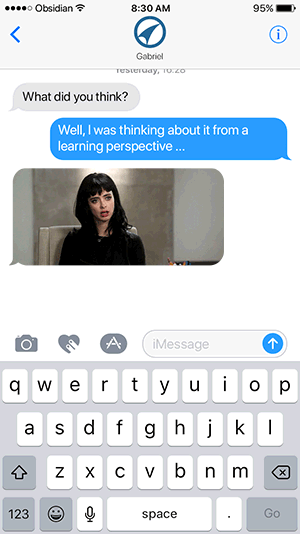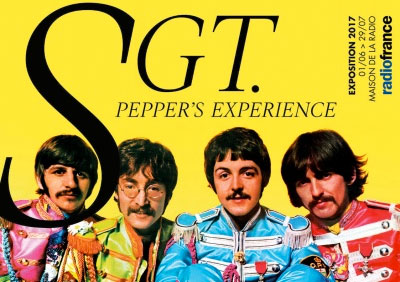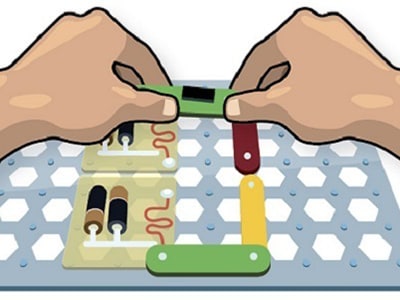 In his defense, Gabriel might have heard that from me before. I imagine that just once, he’d like to hear my reaction to something without it being filtered through a learning lens. There was the time I helped him with a public service announcement project at school; I wouldn’t stop babbling about the importance of the “emotional hook”. Then the time he told me about one of his teachers using a trashcan wastepaper basketball game as a form of in-class motivation, and I provided him with a long-winded explanation of the term “gamification” that he probably didn’t need to hear. I’m guessing that when I suggested a visit to the Sgt. Pepper’s Experience exhibit he thought he was safe from my particular brand of proselytization. Not this time, kiddo.
In his defense, Gabriel might have heard that from me before. I imagine that just once, he’d like to hear my reaction to something without it being filtered through a learning lens. There was the time I helped him with a public service announcement project at school; I wouldn’t stop babbling about the importance of the “emotional hook”. Then the time he told me about one of his teachers using a trashcan wastepaper basketball game as a form of in-class motivation, and I provided him with a long-winded explanation of the term “gamification” that he probably didn’t need to hear. I’m guessing that when I suggested a visit to the Sgt. Pepper’s Experience exhibit he thought he was safe from my particular brand of proselytization. Not this time, kiddo.
Gabriel is a vinyl-loving music fan. He has very eclectic tastes, and when by chance I heard of an exhibit celebrating the 50-year anniversary of the Beatles album “Sgt. Pepper’s Lonely Hearts Club Band”, I knew it would be right up his alley.
It was advertised as an interactive experience, and it truly did not disappoint. The exhibit was designed to resemble a pop-up book composed of ten pages, with each “page” corresponding to a specific theme and accompanied by musical, audiovisual, and radiophonic interactions. In groups of four – just like the Beatles – and provided with headphones at each stop, visitors (re)discover the visual and auditory universe created by the Beatles in the Stg. Pepper’s album.
The visual pop-up display varied at each station, combining video and static elements, and sometimes was more akin to what you might find in an art gallery (one of my favorites was a Beatles “tree”; the leaves were photos of the band members hung on the branches by bits of twine). The audio commentary always related to the visual, and provided the musical and historical context of the Sgt. Pepper album.
At some stations visitors remained standing, and at others beanbags were available. When the subject turned to the Asian influences heard in the album, visitors were invited to recline on a dais while sitar music and kaleidoscopic video played overhead…quite groovy.
And it wasn’t all just “see” and “hear”; the interactive element was woven throughout. In a mock (though extremely realistic) recording studio visitors were invited to “mix” the music on computer displays. To hear the commentary at the last station, and a final rendition of “All You Need is Love”, the group of four that has moved through the exhibit together must link hands, and the individuals on either end of the four-person chain must place their free hands on a designated spot on the wall (I’m still wondering how that works, technically speaking). At the exit, visitors are provided with chalk and encouraged to draw doodles and write their impressions on a large blackboard.
Gabriel and I learned quite a bit during our trip through Beatles land. For example, I had no idea that just prior to working on this album the band had decided to renounce touring. Free from the constraint of trying to reproduce studio music at live events, their creativity was unleashed, allowing them to explore new sounds and new ways of producing unique sounds. They were also the first modern musical group to book a studio for months at a time, whittling down the song list and honing the music until they were completely satisfied with result.
Those interesting tidbits got us both wanting to learn a bit more. I’ve started reading a history of the Fab Four (“Shout!” by Phillip Norman, but take your pick), and my son is impatiently awaiting the arrival of the vinyl copy of “Sgt. Pepper’s Lonely Hearts Club Band” that he ordered within minutes of leaving the exhibit…and I’m fairly certain that the display of various artists’ 1967 album covers will be inspiring future purchases.
Overall, I consider the outing a home run. A cleverly packaged event, combining visual, auditory, and interactive elements, that leaves you wanting to learn more; both inspirational and aspirational in terms of future learning designs.








